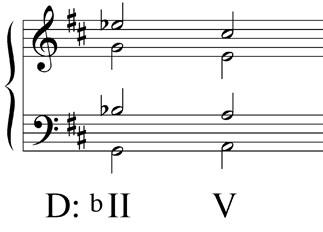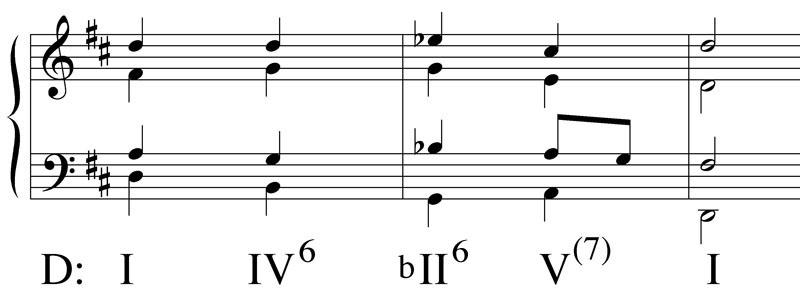28 Neapolitan Chord
Categorized as a terminal pre-dominant, the Neapolitan chord affords the composer a dramatic choice (within the Common Practice vocabulary) to prepare the listener for the arrival of the cadence. As with the various augmented sixth chords, the origin of its nomenclature is obscure.
Steps to Create a Neapolitan Chord. In order to correctly articulate the Neapolitan, chromatic alterations will need to be employed. The following is one method to derive the chord:
a. begin with the chord built on the second scale degree (be it major or minor);
b. chromatically raise the third (or third and fifth if minor) by an augmented unison to create a major triad;
c. lower the entire chord by an augmented unison.
Note that the analytical notation for the Neapolitan can be either N or bII.

Resolution. As a terminal pre-dominant, the normal resolution of the Neapolitan is to the V chord. During its inception, a standard configuration of the bII calls for a doubling of the third of the chord (rather than the root or fifth, as is required elsewhere) and in first inversion (which is the reason why the Neapolitan is often referred to as the Neapolitan sixth). The lower of the two thirds resolves to the root of the V chord while its partner resolves to the fifth of the dominant. The correct voice leading of the root of N is to the leading tone and the fifth of N to the root of V.
Of course there are many exceptions to this typical resolution, and the student is encouraged to explore alternate voicings that maintain a degree of consistency within the framework of the vocabulary at hand.

Neapolitan Sixth in Context. Here we see that the use of the Neapolitan is similar to some of its other terminal pre-dominant neighbors: that of an interjection within the course of a diatonic progression leading to (and immediately preceding) the dominant.


